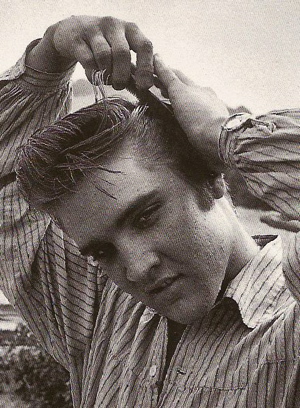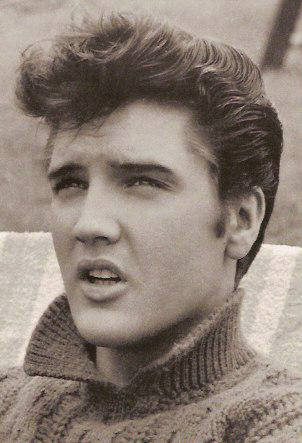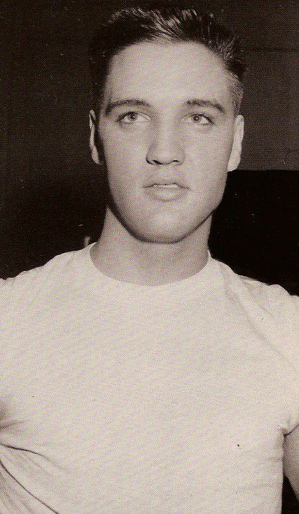An Elvis Haircut in '56
"He was a nice kid, even if he looked a little out of place in the sea of kids with crew cuts and pink scalps. He was pasty-faced with a virulent case of acne. He had long brown hair cut in ducktail fashion. The handfuls of Vaseline he put on it made it look much darker than it was. Long sideburns intruded into the acne." That's how Red West remembered Elvis Presley when both attended Humes High School in the early 1950s. Red related his story to Steve Dunleavy, who, in 1977 recorded it in Elvis: What Happened?
 While conformity in the post-war years dictated for men either a flat top or a crew cut (both variations of the standard military haircut), Elvis's unconventional hairdo was even then his most noticeable physical characteristic. "He would spend hours in the school washroom combing his ducktail to perfection," Red recalls. "It was that hair, man—it got him into all kinds of trouble. If he had a regular haircut like the rest of us, he probably wouldn't have been bothered. But I guess the other kids thought he was trying to show off or something. That hair has always been his crowning glory. I have never known any other human to take more time over his hair. He would spend hours on it, smoothing, mussing it up and combing it and combing it again."
While conformity in the post-war years dictated for men either a flat top or a crew cut (both variations of the standard military haircut), Elvis's unconventional hairdo was even then his most noticeable physical characteristic. "He would spend hours in the school washroom combing his ducktail to perfection," Red recalls. "It was that hair, man—it got him into all kinds of trouble. If he had a regular haircut like the rest of us, he probably wouldn't have been bothered. But I guess the other kids thought he was trying to show off or something. That hair has always been his crowning glory. I have never known any other human to take more time over his hair. He would spend hours on it, smoothing, mussing it up and combing it and combing it again." When Presley's singing career exploded several years later, his unfashionable hairstyle became the topic of much discussion. Critics saw it as a sign of the singer's denunciation of the era's established values, and a conviction grew among adults that boys who opted for an "Elvis haircut" were on the road to moral depravity.
Take the case of Robert Phernetton. The sixteen-year-old showed up at his Romeo, Michigan, high school in the fall of 1956 with an "Elvis haircut." On November 6 he was suspended and told not to return to school until he had a "conventional" haircut. A United Press wirephoto a week later showed Robert combing the offending hairdo as he looked into a mirror, much like Elvis loved to do. A follow up UP article noted that, "Actually, most people who saw Robert's haircut didn't think it too extreme. They thought it had a long way to go to catch up with Elvis."
• Attorney argued freedom of expression
Robert flatly refused to change his hairstyle. His parents supported him and they went to court hoping to force Principal Harold F. Barr to readmit their son to school, sideburns and all. A show cause hearing was held November 16, 1956, in the Macomb Circuit Court before Judge Alton Noe. Four School Board members, three with thinning hair and the other with a crew cut, were also named as defendants in the case.
At the hearing, the Phernettons' attorney, James C. Daner, maintained that the principle of the thing was more important than the haircut itself. "I may not like the haircut," he argued. "The court may not like the haircut, but I defend his right to wear it that way." The School Board's attorney, William Nunnelley, countered with the claim that there was a "direct connection between the way students wear their hair and how they perform in the classroom." Daner then produced a 1954 school yearbook. "Look," he told the judge. "In 1954 he had short hair and he failed a subject." That brought Nunnelley to his feet. "Look at him this year," he said. "He has long hair and has failed all his subjects."
 Although the connection between a student's haircut and his grades seems a stretch these days, there is some evidence that there might have been something to it in the fifties. In one of his weekly "What Young People Think" syndicated newspaper columns, pollster Eugene Gilbert concluded that teenagers who liked Elvis Presley got lower grades and were involved in fewer school and church activities than teenagers who disliked Presley.
Although the connection between a student's haircut and his grades seems a stretch these days, there is some evidence that there might have been something to it in the fifties. In one of his weekly "What Young People Think" syndicated newspaper columns, pollster Eugene Gilbert concluded that teenagers who liked Elvis Presley got lower grades and were involved in fewer school and church activities than teenagers who disliked Presley. Besides the unscientific nature of such polls in 1956, there is also the "chicken before the egg" factor to be considered in such questions. That is, did Elvis Presley cause students like Robert Phernetton to get bad grades, or were students who were already getting low grades drawn to Elvis as a symbol of their existing disenchantment with school? Logic suggests the latter was true. Teenagers who felt alienated in the lockstep conformity of the post-war decade certainly must have seen a champion and a leader in Elvis Presley, who, in his appearance and music was challenging the norms of the day.
Although no expert witnesses appeared at the show cause hearing in Romeo, Michigan, on November 16, 1956, one did testify through the press. On the same day as the trial, an Associated Press article, headlined, "Elvis-Type Haircuts Labeled 'Emptiness, Lostness Badge,'" appeared in newspapers across the country. It reported comments made by Dr. Ralph D. Rabinovitch, director of a University of Michigan neuropsychiatrict clinic for children.
"We have reason to be concerned," Dr. Rabinovitch said about the interests and idols of teenagers. "The fact that teenagers tend to enjoy and emulate the symbolic gyrations of an Elvis Presley is not the whole problem. The problem lies in the fact that a startling number appear to have no other interest or identification and are finding their total satisfactions in the most superficial and transitory ways that our culture has to offer."
Dr. Rabinovitch predicted that many of the nation's children are "doomed to a sadly delinquent heritage" if they don't develop a more positive relationship with school. "Teenagers who have failed to find more meaningful values are disrupting school programs and setting a pattern disturbing to the entire adolescent group. They wear the badge of their emptiness and lostness in their dress and coiffure."
 In his Michigan courtroom, Judge Noe agreed. In upholding the right of the school to expel Robert Phernetton, the judge explained, "The court does not quarrel with the right of the individual to be as ridiculous as he chooses to be. However, the School Board has the responsibility to maintain discipline."
In his Michigan courtroom, Judge Noe agreed. In upholding the right of the school to expel Robert Phernetton, the judge explained, "The court does not quarrel with the right of the individual to be as ridiculous as he chooses to be. However, the School Board has the responsibility to maintain discipline."
 In his Michigan courtroom, Judge Noe agreed. In upholding the right of the school to expel Robert Phernetton, the judge explained, "The court does not quarrel with the right of the individual to be as ridiculous as he chooses to be. However, the School Board has the responsibility to maintain discipline."
In his Michigan courtroom, Judge Noe agreed. In upholding the right of the school to expel Robert Phernetton, the judge explained, "The court does not quarrel with the right of the individual to be as ridiculous as he chooses to be. However, the School Board has the responsibility to maintain discipline."• Elvis hair remained subject of interest
Robert remained defiant. Despite his attorney's and his mother's urging him to comply with the court ruling, the boy insisted he would keep his Elvis Presley hairstyle. If he had to, he planned on taking his haircut to another school. And so Robert Phernetton, representing thousands of rebellious teenage boys who aped Elvis Presley's hair, faded from sight, a mere footnote in pop culture history.
Not so with Elvis's hair itself, however. For two more years, it remained the subject of public fascination. Occasionally Presley's wavy locks made news, such as when a group of Philadelphia fraternity brothers plotted to kidnap the singer and shave him bald in 1957. Then there was the fake haircut in the movie Jailhouse Rock that same year and the real trimming he got on entering the army in 1958. By the time Elvis left the military in 1960, accepted hairstyles had lengthened and Elvis's own had receded to the point where his hair was no longer an issue. But in 1956 it sure caused some angst among those saw an "Elvis haircut" as a sign of "emptiness and lostness" in American's youth.
Alan Hanson
3 comentarios:
clark robert phernetton sr is my father.thanks for writing the article.
clark robert phernetton sr is my father.thanks for the article.
Your father is in Elvis´s Story, great honour know you.
Publicar un comentario